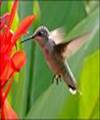Scientific Classification:
|
Other Common Names:
The other common names for the herb Monarda didyma are Bergamot, Scarlet Beebalm, Scarlet Monarda, Oswego Tea, or Crimson Beebalm. History


Bee Balm has a long history of use as a medicinal plant by many Native Americans including the Blackfeet. The Blackfeet Indians recognized this plant's strong antiseptic action, and used poultices of the plant for skin infections and minor wounds. A tea made from the plant was also used to treat mouth and throat infections caused by dental caries and gingivitis. Bee Balm is the natural source of the antiseptic Thymol, the primary active ingredient in modern commercial mouthwash formulas. Bee Balm was also used as a carminative herb by Native Americans to treat excessive flatulence.
Description

Range
Bergamot is extensively grown as an ornamental plant both within and outside its native range; it is naturalized further west in the United States and also in parts of Europe and Asia.Habitat
Moist soils in rich woods, thickets and bottom lands. The plant prefers light (sandy), medium (loamy) and heavy (clay) soils and can grow in heavy clay soil. The plant prefers acid, neutral and basic (alkaline) soils. It can grow in semi-shade (light woodland) or no shade. It requires moist soil.Cultivation
It grows best in full sun, but tolerates light shade and will thrive in any moist soil that is well-drained. Several cultivars have been selected for different flower color, ranging from white through pink to dark red and purple. It is a very ornamental plant and readily propagated by its creeping roots and by slips or cuttings, which, if planted in a shady corner in May, will take root in the same manner as the other Mints. Easily grown in ordinary garden soil so long as it is not too dry. Grows well in heavy clay soils. Requires a moist soil and a sunny position. Prefers some shade but succeeds in a sunny position so long as the soil does not dry out. Plants are hardy to at least -25°c. The flowers are rich in nectar and are very attractive to bees. A good companion plant, it grows well with tomatoes. Bergamot is a very ornamental and aromatic plant, it is often grown in the herb garden, and there are some named varieties. The leaves, stems and roots carry a delicious aromatic orange-like perfume when crushed. Plants are subject to mildew in dry summers.Propagation
Seed - sow mid to late spring in a cold frame. Germination usually takes place within 10 - 40 days at 20°c. When large enough to handle, prick the seedlings out into individual pots and plant them out into their permanent positions in early summer. The seed can also be sown in situ in late summer in areas where the winters are not too severe and will produce larger plants. Cuttings of soft basal shoots in spring. Harvest the shoots with plenty of underground stem when they are about 8 - 10cm above the ground.
Flowering Season
Flowering Season generally lasts from July to September. It delights in a moist, light soil and in a situation where the plants have only the morning sun, where they will continue in flower longer than those which are exposed to the full sun.Pests and Diseases
Powdery mildew may occur. Plant mildew-resistant varieties such as 'Marshall's Delight.' Spray with horticultural oil before mildew develops and regularly after that.Parts Used
  |
The flowers and the leaves are the most essential parts of the herb which are used both for medicinal and general applications |
Medicinal Applications
Bergamot is often used as a domestic medicine, being particularly useful in the treatment of digestive disorders. An infusion is used in the treatment of flatulent colic and sickness; it is also used as a diuretic to treat urinary disorders. An essential oil from the herb is mainly used externally as a rubefacient in the treatment of rheumatism etc. They are popular as an alternative to standard Western allopathic medicine for a variety of problems, including clearing sinuses, nausea as well as coughing.Bergamot is thus widely used for the following
- nausea
- digestive problems and upsets
- vomiting
- vomiting
- colds and flu
- coughing
- antiseptic and decongestant
- nasal congestion
- tight chest
- clearing sinuses
- drying up mucus
Commercial Applications
The flowers and leaves are good ingredients for potpourri making. Leaves and young shoot tips - raw or cooked. They are used as a flavouring in salads, fruit salads, drinks etc. Flowers - raw. They are added as an attractive garnish to salads.An excellent aromatic tea is made from the fresh or dried leaves and flower heads. The leaves give an Earl Grey flavour to China tea. Yields an essential oil, used in perfumery, as a hair tonic etc. The leaves, stems and roots carry a delicious aromatic orange-like perfume when crushed.
Cultural and Religious Importance
Bee Balm was known as the Elixir of Life. It is said that the plant is named after the Greek nymph Melissa, protectress of the bees. The name Melissa is said to be an abbreviation of the Latin name melissophyllum meaning bee plant or leaf. Melissa being a Latin derivation of the Greek word for honey bee.Officinalis indicates that the plant is medicinal in nature. Londoners of Elizabethan times would carry small bouquets, called Tussie Mussies, filled with aromatic herbs and flowers, including Lemon Balm, which they would frequently sniff to get rid of stench of the unsanitary conditions.Symbolism
This herb is used to symbolize money, prosperity, protection from evil and illness; improves memory, stops interference; success, psychic powers, fertility and promotes restful sleep.
Folklore and Myths
Many North American tribes used this plant in healing and spiritual ceremonies. It is known in some parts as "Oswego Tea" because an infusion of it's your leaves is used as a beverage. Bees delight in the nectar of the flowers, earning the herb the name "Bee Balm"


